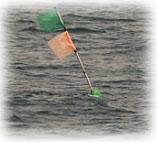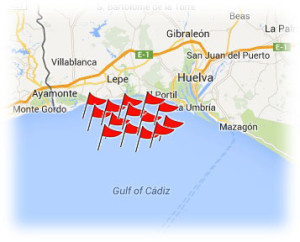You think pot will never get the better of you,
But, sooner or later, you find yourself hooked.

One-half of the acronymical PIGS, the economies of Spain and Portugal are rather ignominiously in the dog-house at the moment. On some measures, such as not requiring a bail-out and still being able to borrow freely on the international money-markets, Spain is faring rather better. If the activity of their pot-laying fishermen is anything to go by, as observed on a sail across their southern border recently, one may hazard a guess as to why that is.
Pot paraphernalia
Sailors familiar with shallow, coastal waters where marine life is abundant (or perhaps just very dumb) will almost certainly be familiar with the marine menace of fishermen’s pot buoys. Those who confine their sailing to deeper waters or ones remote from the fishing industry may have lived a sailing life mercifully free of them.
For the uninitiated or unfamiliar then, permit me to explain.
Keen to snaffle such bottom-dwelling piscine prizes as lobsters and crabs, fishers of shallower seas lay baited pots on the seabed for the dumber denizens of the not-so-deep to crawl into. In order for the owner to retrieve his pot some time in the future they’re marked with a floating buoy on a long rope. Conscientious crustacean catchers will mark their buoys with some sort of flag to distinguish their own pots from those of their competitors and to help other sea users see them and therefore avoid them. Less conscientious ones may simply use an old plastic bottle or any other inexpensive floating object to mark and retrieve their pots. Really unconscientious ones may leave a generous length of floating rope attached to their budget-buoys to make them even easier to retrieve.
For more modestly proportioned yachties though they’re rather more like free sea-anchors, ideal for slowing your speed and disabling your propeller. They are, therefore, perfect for turning a gentle few hours coastal passage making under auto-helm into an eye-exhausting afternoon squinting across the bows or an emotionally exhausting night praying to lady luck.
Pot politics
Off Portugal’s Algarve coast pot buoys are definitely a concern in shallower water; a regular if not rife obstruction on your course to steer. On the whole well-marked they’re frequent enough to guarantee avoiding action at some point on your passage yet infrequent enough for you to occasionally be lulled into a false sense of security.
Only once did we have a crap-yourself moment when one of the shoestring-budget, unmarked “stealth pots” appeared a couple of boat-lengths off our nose. A quick bear-away was enough to slip by it downwind, though under sail and with the folding propeller tucked nicely away the risk wasn’t too great anyway.
Crossing into southern Spain though, we weren’t quite so lucky.
Pot hookah
 Spanish fishermen may not be hooked on pot, but they certainly seem to be hooked on speed. I’ve never sailed a minefield of pots like the one I found off the coast between Ayamonte and Mazagon. The underwater pipeline near Mazagon, with “No Fishing” signs prominent on its marker buoys provided some short-lived but far from total relief. A passing game of count-the-pots amongst my shipmates routinely yielded twenty-plus in sight at any one time.
Spanish fishermen may not be hooked on pot, but they certainly seem to be hooked on speed. I’ve never sailed a minefield of pots like the one I found off the coast between Ayamonte and Mazagon. The underwater pipeline near Mazagon, with “No Fishing” signs prominent on its marker buoys provided some short-lived but far from total relief. A passing game of count-the-pots amongst my shipmates routinely yielded twenty-plus in sight at any one time.
This really was a pot slalom sea; one where pot-avoidance tactics where having a material impact on our course since we were avoiding downwind so much. This was a torture to put waterboarding to shame; when pots weren’t in sight off the bows we were afflicted with pot paranoia, convinced they must be there and we just weren’t seeing them.
It was another “stealth pot” that sneaked up on us and while we did manage to steer off in time to pass it about a boat-length off our port bow, as it came amidships it suddenly bobbed and started heading towards us leaving a clear wake behind it. A very lengthy floating pickup line must have been snagged by our keel and, under engine at the time, was at imminent risk of fouling our propeller. The skipper dived for the engine controls and threw it into neutral.
Maybe we’d have got lucky anyway, or perhaps that quick reaction saved us from an unscheduled snorkel over the side to get us underway again. Either way the pot passed safely astern of us and as it did we could finally see that long length of floating rope snaking behind it, lying malevolently in wait for its next, unsuspecting victim.
Pot rules!
The itinerant skipper-hopping boat-whores amongst us will find themselves plodding through the pots sooner or later. For your edification then, here are what seem to be the rules of the game:-
- Keep an eye out for any pot you’re going to get within two boat-lengths of. This may sound simple but with leeway and tideway to consider and few features to provide a transit for reference it requires a little intuition. Giving a wider berth to anything upwind or upstream of you makes sense. If under sail you need to keep a regular check under the headsail too. It can become quite tiresome and if the helming is easy, it’s easy to get distracted.
- If you’re going to get too close, steer downwind or downstream. This may seem a little counterintuitive since, though it reduces the risk of you misjudging leeway and tideway and being carried on to it, downstream is where any floating ropes are going to be. Hence the need to keep a decent distance.
- Watch close pots when you pass them, especially if under engine. If one suddenly develops a wake and heads in your direction put the engine in neutral quickly. It’ll catch round the keel (presuming you have one) before it gets near your prop so you do have a little time. If under sail without a folding or furling prop, a quick prayer might be in order.
- If you end up with one wrapped round the propeller nautical etiquette (or prison rules, whichever you prefer) mandates it’s the most junior crewmember who will be taking a dip in the icy briny to clear it off. Therefore, either don’t be the most junior crewmember, or don’t trust the bloody helmsman if you are!
- If you end up with one wrapped round the propeller, cosmic justice (or perhaps prison rules again) mandates you can cook what you catch.
Hey, it’s only fair! And I’m rather partial to lobster.